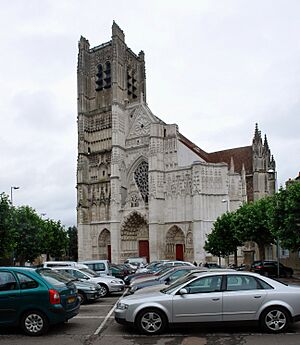Roman Catholic Diocese of Auxerre facts for kids
The Diocese of Auxerre was an important area for the Roman Catholic Church in France. Its main church, called a cathedral, was in the city of Auxerre in a region known as Burgundy. Today, the area is part of the Archdiocese of Sens and Auxerre, and the main leader, the Archbishop, lives in Auxerre.
A Look at the Church's Past
The history of the bishops in Auxerre was written down in a book called Gesta pontificum Autissiodorensium. This book was started around the year 875 by two church officials, Rainogala and Alagus. It was then updated over many years, all the way up to 1278. A historian named Louis Duchesne thought most of the list was correct, but the early dates before the 7th century might not be exact. What's special about Auxerre is how many of its bishops became known as saints!
Early Bishops and Saints
The first leader of the church in Auxerre was Saint Peregrinus. Legend says he was sent by Pope Sixtus II and was killed for his beliefs around 303 or 304 AD.
After Saint Peregrinus, many other important bishops led the church in Auxerre. Here are some of them:
- St. Marcellianus
- Valerianus
- St. Helladius (died 387)
- St. Amator (died 418), who was known for being one of the earliest examples of a special haircut for priests in France.
- St. Germanus of Auxerre (418–448), a very famous bishop. A large church, the abbey in Auxerre, is named after him.
- St. Allodius
- St. Fratemus
- St. Censurius, who received a special book about the life of St. Germain.
- St. Ursus
- St. Theodosius, who attended an important church meeting in 511 called the First Council of Orléans.
- St. Gregorius
- St. Optatus
- St. Droctoaldus
- St. Eleutherius, who went to several church meetings between 533 and 549.
- St. Romanus (died around 564)
- St. Actherius
- St. Aunacharius (573–605), who was the uncle of St. Lupus. St. Aunacharius held a special meeting, the Council of Auxerre, which showed how people lived, both the new Christian tribes and the older Roman people.
- St. Desiderius
- St. Palladius, who attended several church meetings in 627, 650, and 654.
- St. Vigilius, who was sadly killed around 684.
- St. Tetricius (692–707)
- Savaric (710–715)
- Aidulf (around 751–766)
- Maurin (around 766–794)
- Blessed Aaron (around 794–807)
- Blessed Angelelmus (807–828)
- St. Heribaldus (829–857), who was a trusted helper to Louis the Pious, a king, and often went on important trips for him.
- St. Abbo (857–869)
- Blessed Christian (860–871)
Later Bishops of Auxerre
The list of bishops continued for many centuries. Here are some of the notable ones:
- Wibaldus (879–887)
- Herifridus (887–909)
- St. Géran (909–914)
- St. Betto (933–961)
- Guy (933–961)
- Heribert I (971-996)
- John (996–999)
- Hugh of Chalon (999–1030)
- Heribert II (1039-1052)
- Geoffrey of Champallemand (1052-1076)
- Robert of Nevers (1076-1092)
- Humbaud (1095–1114), who sadly drowned on his way to Jerusalem.
- St. Hugues de Montaigu (1116–1136), a good friend of St. Bernard.
- Hugues de Mâcon (1137–1151), who was often asked by Pope Eugenius III to help solve problems in monasteries.
- Alanus (1152–1167), who wrote a book about the life of St. Bernard.
- Guillaume de Toucy (1167–1181), the first French bishop to travel to Rome to show respect to Pope Alexander III.
- Hugues de Noyers (1183–1206), known for strongly opposing groups like the Albigenses who had different religious beliefs.
- Guillaume de Seignelay (1207–1220), who took part in a war against the Albigenses and later became the bishop of Paris.
- Henry of Villeneuve (1220–1235)
- Bernard de Sully (1235–1244)
- Guy de Mello (1247–1270), who was a special representative for a crusade led by Charles of Anjou.
- Pierre de Mornay (1296–1306), who helped with talks between Pope Boniface VIII and King Philip IV. He also became the chancellor of France.
- Pierre de Cros (1349–1351), who became a cardinal in 1350.
- Pierre de Longueil (1449–1474)
- Enguerrand Signart (1474–1477)
- John III Baillet (1477–1513)
- François de Dinteville (1513–1530)
- Philippe de Lenoncourt (1560–1562), who became a cardinal in 1586.
- Philibert Babou de la Bourdaisière (1562–1570), who became a cardinal in 1561.
- Jacques Amyot (1571–1593), a famous scholar who translated important works. He was also a teacher to King Charles IX and a high-ranking church official for Kings Charles IX and Henry III.
- Pierre de Broc (1640-1671)
- Charles de Caylus (1704–1754), who made his diocese a center for a religious movement called Jansenism. His published writings were later not approved by the church in Rome.
The Diocese of Auxerre was officially closed on November 29, 1801. It was brought back for a short time in 1817 but then closed again in 1821. In 1823, it was joined with the Diocese of Sens. This combined diocese later became an archdiocese. However, in 2006, it changed again and became part of the Dijon church province.
The main church, the Cathedral of Auxerre, was finished in 1178. It has many beautiful sculptures in a style called Byzantine.
See also
- Catholic Church in France
- List of Catholic dioceses in France


